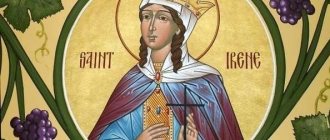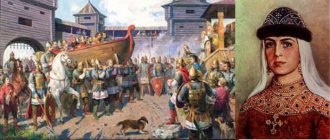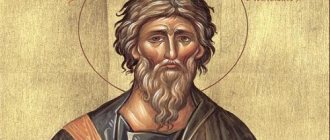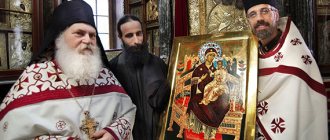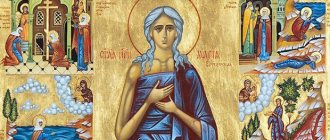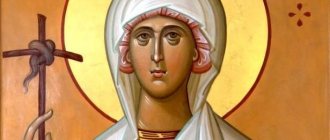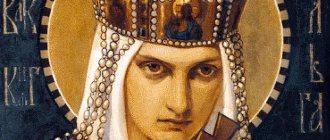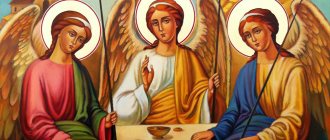My sister's name is Ira. Like most modern girls, when she was little, she went to church with her mother, and when she grew up, she began to study and work, and forgot about spiritual matters. But in vain! To get her interested in Orthodoxy, I began to study the biography of my sister’s “personal saint” and retell it to my sister. The life of Irina Makedonskaya is really worth a separate discussion. And the icon of the saint, which has been in our house for many years, is not just considered a strong helper from many troubles.
Life of Saint Irene
She is one of the earliest Christians.
Find out what awaits you today - Horoscope for today for all zodiac signs
In the 1st century, a girl was born into the family of a rich man (the ruler of a region in Macedonia), who was named Penelope. From childhood she was surrounded by servants, she lived in a palace, and when she grew up, a teacher was hired for her so that she could comprehend various sciences. But besides reading and writing, this teacher (his name was Apelian) instilled in the girl a love of God.
When she grew up, her parents decided to find her a husband. But something amazing happened - several birds flew into Penelope’s room:
- a crow carrying a snake (this image is deciphered as the temptation of the unclean);
- a dove with an olive branch in its beak (a sign of the grace of the Lord);
- an eagle in whose talons there was a wreath (which can be understood as greatness due to service to the Creator).
Penelope didn't know how to understand these signs. Her teacher explained that the Lord wanted her to devote herself to Him, but because of this the girl would have to go through many hardships.
Due to numerous requests from readers, we have prepared an “Orthodox Calendar” application for smartphones. Every morning you will receive information about the current day: holidays, fasts, days of remembrance, prayers, parables. Download for free: Orthodox Calendar 2022 (available on Android)
She renounced marriage and openly converted to Christianity. The Apostle Timothy himself baptized her. From him she received her new Christian name.
Miracles of Faith
Having become a Christian, Irina began to convert her family to the true path.
Her mother was glad to let the Lord into her heart, but the girl’s father was at first skeptical about her choice, and then became angry. He forbade him to talk about Christianity, and when Irina finally abandoned paganism, he ordered her to be thrown into prison, and if she did not come to her senses, order the servants to throw the girl under the hooves of horses.
The next morning Irina was taken out of prison, but the horses refused to trample her. On the contrary, one animal rushed at her father, Licinius, and, after striking several blows with its hooves, bit off his hand.
The man was doomed to die from loss of blood. But Irina threw herself on her knees next to her father and began to pray to the Lord for his health. To the surprise of everyone present, the arm grew back!
Needless to say, after this incident the father not only did not forbid Irina from preaching, but he himself was baptized. Like all the people who saw this miracle.
Martyr's path
Of course, Licinius could no longer hold the position of ruler, and a new man was sent in his place - Zedekiah.
He really didn’t like the fact that a beautiful girl, famous for her miracle, was preaching in Macedonia. He ordered her to be brought to him and began to force her to leave Christianity. When Irina refused, he ordered her to be killed, and that her death would be terrible.
- First they threw her into a pit filled with snakes. But when 10 days later people came to take out the girl’s body, they saw that Irina was unharmed - the Lord had protected her.
- After this, Zedeki ordered her body to be cut into pieces. But all the saws that were brought to the place of execution broke and did not harm the righteous woman. Only one lightly scratched her skin.
After this, everyone present leaned towards Christianity. The people drove out the evil Zedekiah. And, although another atheist was sent in his place, who also tried to subject Irina to torture, he also could not harm her.
The saint continued to preach, and during her life she convinced about 10 thousand people to be baptized. She had many students. Also, her teacher, Apelian, did not leave her until her death.
Irina visited many cities, and ended her earthly life in Ephesus. It turned out amazing: the Lord told her to enter the cave with the teacher and students. People from the entrance closed the cave with a stone. When they rolled it back 4 days later, it turned out that the cave was empty.
Definition of angel day
Each person is named at birth, that is, they are given a name that will accompany him throughout his entire life.
Some people mistakenly believe that with the appearance of a name, a guardian angel, a heavenly patron, also appears in a person. It's not like that at all. The Lord from heaven gives a person a guardian angel only at the moment when he receives the sacrament of baptism. How to find out which date is the angel's day (name day)? There's nothing complicated about it. It is enough to know the person's name and date of birth. For example, the name is Nikolai, the date of birth is April 30. The nearest holiday according to the Orthodox calendar is the Day of St. Nicholas of Myra (Nicholas the Pleasant), which is celebrated in May. It is on this day that Nikolai, born on April 30, will receive congratulations on Angel Day.
The most revered icon in our country
Irina is depicted on it at the age at which she became a Christian - at 19 years old. In one hand she holds a cross, showing it to us, and presses the other to her chest, proving the truth of her life choice and that it was made sincerely.
Memorial Day of this saint: May 18 (or May 5, old style).
Also held in high esteem is the icon on which the Saint is depicted in all the beauty of her soul, in the greatness of her faith:
What do they pray to Irene the Great?
- About peace, love, well-being in the family.
- About health (your own and your loved ones). People who suffer severe pain (for example, after surgery) especially often turn to her, because the martyr also endured many trials in her time, but did not break.
- About fortitude, confidence in one’s own abilities or one’s business.
- Priests often turn to her for help, asking Irina to grant them eloquence.
- Irina is also an intercessor for people who move to a new place of residence (especially to a new city) or change jobs.
- Well, if you yourself bear this name, you can pray to the Great Martyr Irina for everything that hurts in your soul.
How to pray to a saint
Before the icon, you can read prayers and an akathist, or a canon to the great martyr, and if you don’t have texts of prayers at hand, then you can pray in your own words - no problem. The main thing is faith in the prayerful intercession of the saints for us before the Lord.
It is also advisable to combine home prayer with church prayer, that is, come to church and pray there, and also receive the Sacraments. The temple building strengthens human prayers, in addition, it is a place of special presence of God.
Holy Great Martyr Irene
IRINA
(† 50s of the 3rd century), mts. Corinthian (memorial April 16; memory Byzantine April 16, 17). Information about I.'s martyrdom is contained in the Synaxarion of the K-Polish church. (archetype of the late 10th century) and in the Minology of the Emperor. Vasily II (late 10th - early 11th century). In the Synaxar, a short Life of I. is given under April 17, in the Minology of Vasily II - under April 16. According to these sources, I. accepted martyrdom after the martyr. Leonidas and the virgins who suffered with him (see art. Codratus, martyr, and other martyrs of Corinth). I. was originally from Greece. On one Easter day, she and other Christians were in a prayer house. This was reported to the ruler of the region; all those gathered were captured and taken to the city of Corinth. I. was interrogated and imprisoned, then she again appeared before the court and was tortured (the saint had her tongue cut and her teeth pulled out). After torture, I. was beheaded with a sword.
Traditionally, the date of I.’s death is considered to be 258, based on the fact that the saint suffered shortly after the martyr. Kodrat and his followers. However, this dating is not entirely justified. In various editions of the Martyrdom of St. Kodrata is mentioned by imp. Decius, who reigned in 249-251. The Martyrdom of Nikephoros Gregoras (BHG, N 358) speaks only about Decius, and in 2 others (BHG, N 357 and AnBoll. 1882. Vol. 1. P. 448-468) it also talks about Valerian (253-260 ). However, in reality, Decius and Valerian were not co-rulers, and one was not even the successor of the other. But it is known that under both Decius and Valerian there were periods of persecution of Christians (Decius’s decree dates back to 250, Valerian’s 1st decree to 257). In this case, the death of Kodrat and his followers (including I.) can be approximately dated to the 50s. III century According to Minology imp. Vasily II, during the period of persecution of the emperor. Decius suffered from Codratus's mother, and not he himself (she was forced to flee to the mountains from his pursuers), but the saint suffered martyrdom as an adult, that is, much later than 258.
Due to the fact that the texts of the Martyrdom of Kodrat contain information about the martyr. Leonidas and the virgins who suffered with him (however, I. is not mentioned among them in any of the editions), scientists have suggested that the celebration of the memory of I. on April 16 is the result of a mixture of veneration of the Corinthian martyrs and martyrdom. Irina, who suffered in Thessalonica along with the martyrs Agapia and Chionia (whose memory is also celebrated on April 16; see in Art. Agapia, Chionia and Irina, martyrs of Thessaloniki (Illyria)).
Source: ActaSS. Apr. T. 2. P. 400-401; PG. 117. R. 405-408; SynCP. Col. 605-606, 610; Νικόδημος. Συναξαριστής. Τ. 4. Σ. 229; JSV. Apr. pp. 242-243.
Lit.: Sergius (Spassky). Monthsword. T. 2. S. 111, 112; T. 3. P. 143; Εἰρήνη // ΘΗΕ. Τ. 5. Σ. 444; Lucchesi G. Irene // BiblSS. Vol. 7. Col. 886-887; Aubert R. Irène // DHGE. T. 25. Col. 1458; Σωφρόνιος (Εὐστρατιάδης).῾Αγιολόγιον. Σ. 124; Holy Great Martyr Irene. M., 2009. P. 258.
T. A. Artyukhova
Temples
In Constantinople, several beautiful churches were built in memory of the follower of Christ. In Pokrovskoye (Russia, Moscow) you can find the Church of St. Irene. The chapel of the holy martyr was added in 1635 to the parish church of St. N. the Wonderworker. In 1790-1792, a church was erected with chapels of the holy martyrs Irina and Catherine. People began to call the temple “Pokrovskaya Irina the Martyr.” In 1891, the church was rebuilt and significantly expanded. During the revolution of 1917, the church was closed and the building itself was partially destroyed. And only in 1992 the holy building was returned to the church. Now the temple is the only one in Moscow consecrated in honor of St. Irene. Now there is a busy life in it. A Sunday school has been opened at the church, where theology is taught, a library, computer classes, and a film library are created. But the Church of the Intercession of St. Irene is not famous for this, but for its beautiful incense, which is called “Irinin”. Here the priest was able to create a laboratory where he studies ancient recipes for preparing fragrant compositions. The aroma of Irina’s incense simply fascinates parishioners. A church in honor of St. Irene can also be found in Volgovo (40 km from St. Petersburg). This village is small, as is the church itself. Now in Volgovo work is underway to reconstruct and restore it. In the future, it is planned to open a museum of Orthodox culture there, for which there are plenty of exhibits and materials collected.
The meaning of the name Irina
Translated from ancient Greek, the name means “peace, tranquility.” A girl named Irina has such qualities as independence, mobility, determination, firmness, and cheerfulness. The name Irina “blesses” its owner with an analytical mind and an excellent sense of humor. In adult life, Irina devotes a lot of time to her career. They often become excellent leaders thanks to a combination of internal balance, prudence and a sense of humor. Irins are good diplomats and psychologists. They feel the interlocutor well and know how to “tune in to his wavelength.” As a rule, girls named Irina are not limited to housework. They prefer to combine career and family.
Miracles of Christ
During her stay in Mygdonia, Saint Irene preached the Christian faith and performed many miracles. With the help of prayer, she healed the sick, drove away demons and cleansed lepers. And one day the girl performed a real miracle: she resurrected a dead young man whose parents were mourning him. Later, Irina moved from Mygdonia to Calliope, and from there to Mesemvria. In every city of Thrace where Irina was, she preached Christianity. But even here it was not without torment. The city rulers were aggressive towards the teachings of Christ and his followers. They tried to burn the girl on a hot grate. But the Lord saved his chosen one from death. The biggest miracle with Saint Irene happened in the city of Mesemvria. The ruler of the city, Prince Savory, ordered the girl’s head to be cut off. And his order was carried out. And then they buried the holy martyr outside the city. But the Lord wanted Irina to continue preaching Christianity, so he resurrected her. The Almighty ordered his follower to return to Mesemvria. Residents of the city could not believe their eyes: in front of them was the deceased Irina. After what happened, Prince Savory and his people believed in the Lord God Christ and received Baptism. It was so difficult for the great martyr Irina to introduce people to the true faith.
